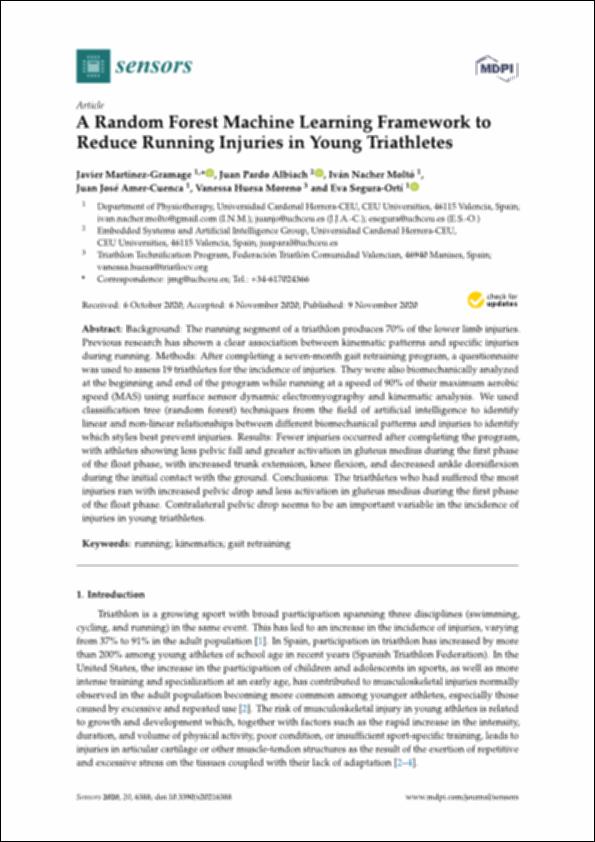Por favor, use este identificador para citar o enlazar este ítem:
http://hdl.handle.net/10637/12454A random forest machine learning framework to reduce running injuries in young triathletes
| Título : | A random forest machine learning framework to reduce running injuries in young triathletes |
| Autor : | Martínez Gramage, Javier Pardo Albiach, Juan Nacher Moltó, Iván Amer Cuenca, Juan José Huesa Moreno, Vanessa Segura Ortí, Eva |
| Materias: | Pelvis - Wounds and injuries - Prevention.; Fisioterapia deportiva.; Sports physical therapy.; Biomecánica.; Pelvis - Mechanical properties.; Carreras (Atletismo) - Accidentes y lesiones - Prevención.; Running races - Wounds and injuries - Prevention.; Pelvis - Heridas y lesiones - Prevención.; Pelvis - Propiedades mecánicas.; Biomechanics. |
| Editorial : | MDPI |
| Citación : | Martínez Gramage, J., Pardo Albiach, J., Nacher Moltó, I., Amer Cuenca, J.J., Huesa Moreno, V. & Segura Ortí, E. (2020). A Random Forest Machine Learning Framework to Reduce Running Injuries in Young Triathletes. Sensors, vol. 20, i. 21 (09 nov.), art. 6388. DOI: https://doi.org/10.3390/s20216388 |
| Resumen : | Background: The running segment of a triathlon produces 70% of the lower limb injuries. Previous research has shown a clear association between kinematic patterns and specific injuries during running. Methods: After completing a seven-month gait retraining program, a questionnaire was used to assess 19 triathletes for the incidence of injuries. They were also biomechanically analyzed at the beginning and end of the program while running at a speed of 90% of their maximum aerobic speed (MAS) using surface sensor dynamic electromyography and kinematic analysis. We used classification tree (random forest) techniques from the field of artificial intelligence to identify linear and non-linear relationships between di erent biomechanical patterns and injuries to identify which styles best prevent injuries. Results: Fewer injuries occurred after completing the program, with athletes showing less pelvic fall and greater activation in gluteus medius during the first phase of the float phase, with increased trunk extension, knee flexion, and decreased ankle dorsiflexion during the initial contact with the ground. Conclusions: The triathletes who had su ered the most injuries ran with increased pelvic drop and less activation in gluteus medius during the first phase of the float phase. Contralateral pelvic drop seems to be an important variable in the incidence of injuries in young triathletes. |
| Descripción : | Este artículo se encuentra disponible en la siguiente URL: https://www.mdpi.com/1424-8220/20/21/6388/htm Este artículo pertenece la número especial "Wearable Sensors & Gait". |
| URI : | http://hdl.handle.net/10637/12454 |
| Derechos: | http://creativecommons.org/licenses/by/4.0/deed.es |
| ISSN : | 1424-8220 (Electrónico). |
| Fecha de publicación : | 9-nov-2020 |
| Centro : | Universidad Cardenal Herrera-CEU |
| Aparece en las colecciones: | Dpto. Enfermería y Fisioterapia |
Los ítems de DSpace están protegidos por copyright, con todos los derechos reservados, a menos que se indique lo contrario.


